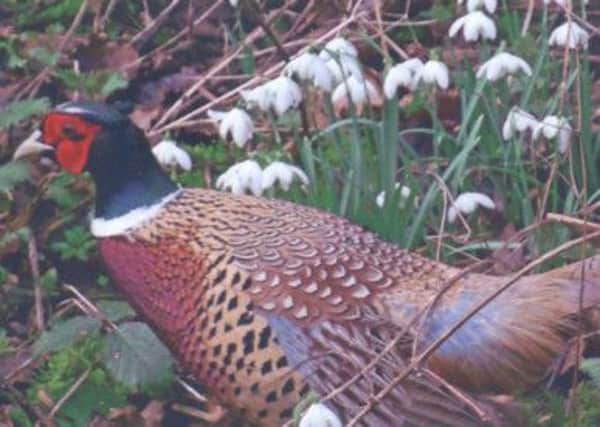Handsome andfriendly but nouse in a fight


Handsome too. Just look at that huge white ring and the little snow drops on his back.
He was full of fight and would challenge every other cock in the woods at dusk like a bugler practising the last post several times over. But when it actually came to pheasant fisticuffs he would run a mile.
Advertisement
Hide AdAdvertisement
Hide AdHis spurs were only warts on his legs whereas one or two older birds sported those of a cavalry officer.
The keeper has corn bins along the rides and Snowdrop was hopeless in competition with the others but would make brave charges through the crowds and maybe find a single grain of wheat before being set upon by the rough boys.
He was a dandy, strutted like a hero in front of the hens which sometimes looked at him but he had no idea what to do next.
He was quite clever though since he realised that humans were actually quite friendly when the shooting season was over.
Advertisement
Hide AdAdvertisement
Hide AdSo he took to taking the corn out of my hand, just like my old tame bird I call Charley, a Southern Caucasian pheasant with no white neck ring and no snowdrops.
Snowdrop kept well clear of Charley. Of course the silly young idiot didn’t last long, strutting about like a Revival look-a-like Admiral or Air Commodore and either a fox or a loose dog got him for there on the path were the remains of his uniform and medals.
That was last year and now with the snowdrops bursting once more out of the ground thoughts return to that hybrid Chinese ring-neck and his place in history.
The pure Phasianus Torquantus is very similar to Snowdrop but has a tinge of green on the rump.
Advertisement
Hide AdAdvertisement
Hide AdSwinhoe, Saurin and Pere David all agreed in 1880 that Torquatus was the most common species in China at that time.
They reported that thousands were shot and brought down to markets at Peking each year. Formosa was said to swarm with them. I wonder how many today live in that polluted country.
I wonder too whether they still exist on the island of St Helena where they were introduced with great success in 1513 under very peculiar circumstances.
Apparently one Fernandez Lopez, having deserted the army was exiled together with others to St Helena and supplied with some roots, seeds, poultry and Chinese Ring-necks and told to survive or die. The pheasants thrived so wonderfully well that on a later visit by Capt Cavendish he reported that they were in great abundance in 1588.
Advertisement
Hide AdAdvertisement
Hide AdTwo hundred years later they were still swarming although due to slightly different diet especially the seeds of Calla aethiopica (relative of sweet flag) the plumage had slightly altered. No wonder snowdrops of various denominations do so well in Sussex.